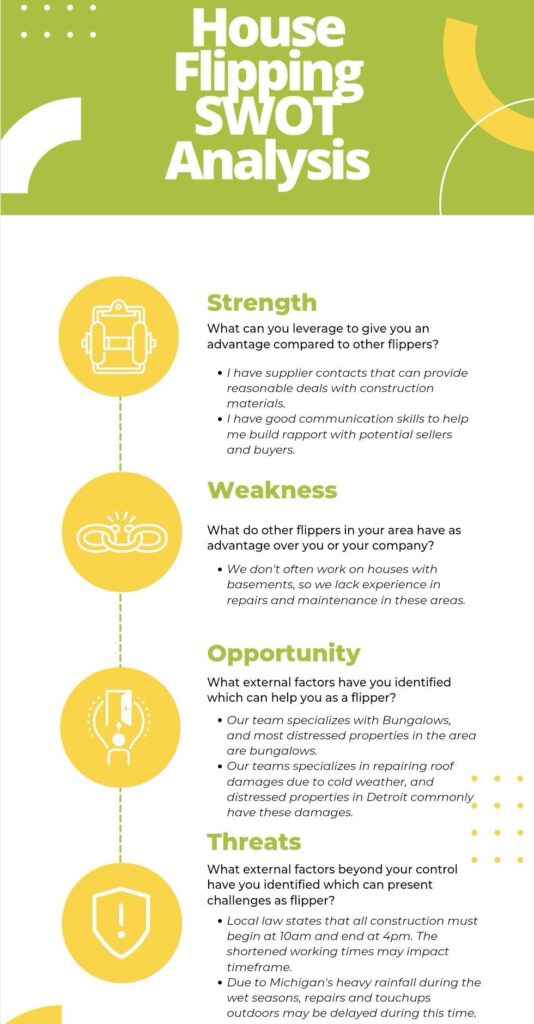As the popular saying goes—” before you sell anything, you first have to sell yourself.” This statement holds true even In the house-flipping business.
Although flipping mainly deals with selling properties, don’t forget that you also have to deal with flippers, real estate agents, buyers, sellers, and other counterparts in the real estate industry. Because of this, in order to do good business and close flipping sales, you’ll first have to market yourself to establish business relations.
Why Market Yourself?
Apart from wondering how to market yourself using the SWOT analysis, you might be wondering why marketing yourself is even necessary.
To help you answer this question, we’ll ask you another question—as an investor, would you put money in an investment you’re not convinced will grow? You probably answered no. The same goes for lenders, investors, and other business prospects in the real estate industry. Before they shell out any money and do work with you, they first need to convince you’re worth the investment.
And how do you market yourself? By showing what you can bring to the table as a house flipper and why your house-flipping empire will be a success. And that is exactly what your SWOT analysis can do.
What is a SWOT Analysis?
The acronym SWOT stands for strengths, weaknesses, opportunities, and threats. The information in its subsections shows your capabilities and how you work as a house flipper in relation to competitors and your place of business.
Through your SWOT analysis, you can be accurately assessed. In effect, this will help lenders, investors, and other prospective business associates determine whether they want to work with you.
Take a look at this generic SWOT analysis to help you form an idea of how it works:

Chances are this is the first you’re hearing of a SWOT analysis since it’s not often used in real estate businesses like house flipping. However, its lack of commonplace use shouldn’t diminish its value.
Remember that house flipping is a business and the SWOT analysis plays an integral role in any business plan.
To help you grasp how you can leverage a SWOT analysis, here are three things you need to take into account: you or your company, your competition, and external factors. Think of you and your competition as the players, the external factors and the place as the stage, and house flipping as the game.
The more knowledge you have of the game, the better you can play it.
If you’re here from previous installments of the house-flipping business plan series, we’re happy to have you back for our third and final installment. If you missed the first two, be sure to check it out so you’re up to speed. In previous installations, we discuss the importance of a house flipping business plan[1] and the step-by-step process of making one[2] .
Here’s a chart that shows a SWOT analysis tailored for a house-flipping business plan:

Now that you have a general idea of the SWOT analysis’ role in a house flipping business plan, let’s dive in deeper and go through each subsection in detail. As we break down the 4 subsections, we’ll also tackle how you can leverage these to market yourself and your company.
Your Flipping Strengths
What advantage do you have going into the house-flipping business? Are you starting off with capital or partnering up with someone who already has experience? List down what you and those you work with can leverage and explain why these are valuable.
Here’s a list of questions to get started:
- What is your competitive advantage (against other flippers in the area)?
- What resources do you have that you can take advantage of?
- What part of your flipping business is performing well above average?
For instance, starting out with capital means you don’t have to worry about securing loans or partnering with investors. Having your own finances to pull from lets you move more independently without relying on third parties for funding.
Showing your strengths is the most persuasive point of a SWOT analysis and is the main determiner of whether people want what you can provide. Your strengths also set what’s expected of you as a house flipper, so be careful not to under or over-sell yourself and highlight your strengths honestly.
Your Flipping Weaknesses
Where do you fall short in the house-flipping business? As important as it is to acknowledge your strengths, it’s equally important to acknowledge your weaknesses. If you’re partnering up or working under someone, this is where they’ll form accurate expectations of you.
For instance, if your network consists of young individuals, your flips will likely be within the city near office buildings. In this situation, you’re likely more familiar with flipping small houses for one or two people. A weakness here can be having no properties outside of the city or a lack of experience dealing with larger houses.
These are some questions you can ask yourself:
- Where in your flipping business can you improve?
- What part of your business is underperforming?
- Where are you lacking in resources?
Identifying your weaknesses also lets you identify areas of improvement so you can actively work on becoming a better house flipper. Although weaknesses show your limitations, this can also work in your favor when doing business with others.
As strengths set what they can expect from you, weaknesses show what they can’t. By considering both your strengths and weaknesses you can be more accurately assessed as a house flipper.
Your Flipping Opportunities
These are external factors that work in your favor. Ask yourself: Which market can you tap into? What are people looking for? Which factors can help me close more deals?
When you identify the opportunities available in your area of business, you can gauge which house flip projects can turn a profit and increase the chances of a return on your investment.
For example, here are the following statistics:
- People aged between 25 and 44 make up 29.8% of Michigan’s population.
- On average, Americans start a family in their mid to late 20s.
Given these statistics, there is an opportunity for flipping houses that cater to young, new families, which is where your business is focused on.
If you’re still not sure where your opportunities are, here are some questions to get the ball rolling:
- What new markets can your business explore?
- What other investment routes can your business potentially consider?
- What technology can you use to improve your operations?
- How else can you expand your core operations?
By narrowing in on house flips with more profitability, you also increase the confidence of prospective business partners, lenders, and investors to work with you.
Your Flipping Threats
On the other hand, threats are external factors that set limits to your house flips. These external factors are often beyond your control, such as the local weather or building policies.
For example, Michigan experiences winters with temperatures as low as 18°F, so you might run into homes that require more winter-proofing, like replacing HVAC systems or adding more insulation. Threats like these can be laborious, requiring you to assess properties with more care.
These are the questions you’d want to ask yourself:
- What local and state regulations threaten your operations?
- In what ways are your competitors doing better than you?
- What are the market shifts and trends that threaten your business?
Moreover, identifying your threats is essentially stating the factors that you can’t be held accountable for, so you can be assessed fairly.
For instance, if you’re being assessed based on a past project that experienced weather-related delays, that shouldn’t reflect badly on your work ethic as a house flipper. You can also think of your flipping threats as a kind of disclaimer.
Is the SWOT Analysis Worth it?
Challenges and growing pains are inevitable when you’re starting a house-flipping business. But remember that you have the power to make the journey easier with a SWOT analysis.
The insight you’ll get from conducting the analysis then becomes your handy cheat sheet. You can now enter the house flipping game with substantial knowledge, fully knowing how other players are doing on the stage, and exactly how you’ll give your business a leg up.
As always, remember to take your time conducting a SWOT analysis with careful consideration. It plays a major role in your house-flipping business plan, so let’s not get too hasty with it.
Be a House Flipper Worth Working With
A house-flipping business plan that comprehensively addresses all possible queries will leave no room for doubt that you will succeed as a house flipper.
This is your chance to lay down the foundation you need to build your house-flipping empire. Use the SWOT analysis as a marketing tool to show others that you’re prepared, knowledgeable, and set up for success—perfect for doing business in the long run.
This is the final installment of our 3-part house flipping business plan series. If you haven’t checked out the two previous installments, you can find these on the links above.
What other real estate business plans do you want us to discuss? Let us know in the comments below! And should you have more concerns, get in touch with us today.


